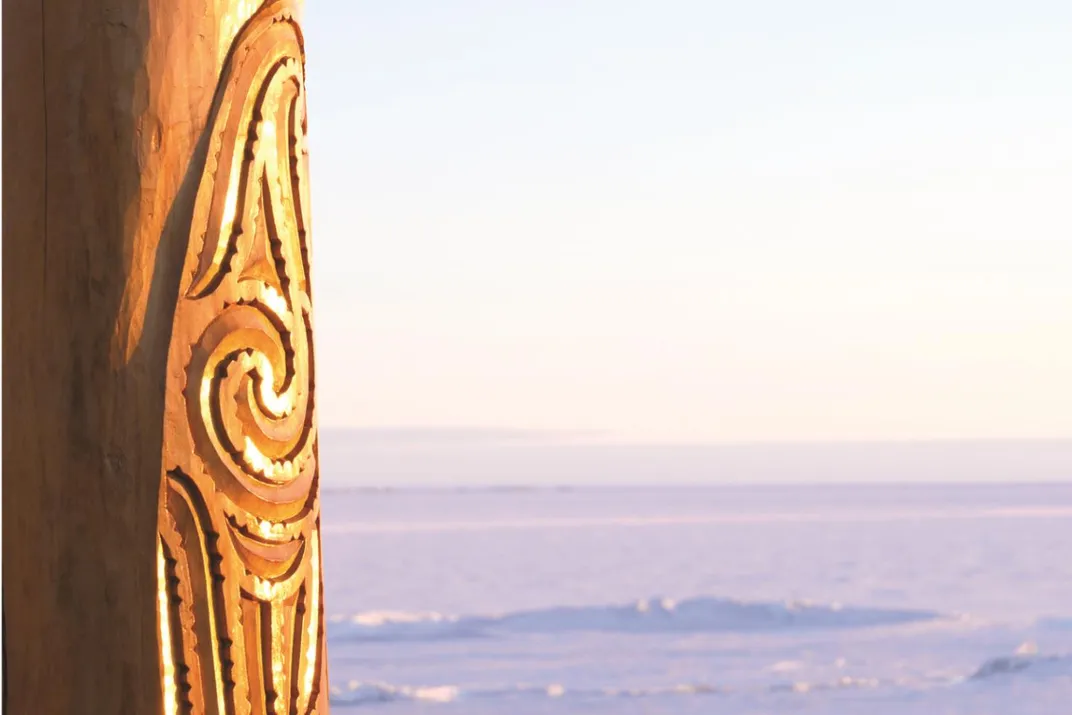Māori May Have Reached Antarctica 1,000 Years Before Europeans
New research draws on oral histories and other traditional records often ignored by Western scholars
:focal(588x417:589x418)/https://tf-cmsv2-smithsonianmag-media.s3.amazonaws.com/filer/ac/6a/ac6a44ce-edf0-47be-875c-6a033c1fca42/glacier_on_antarctic_coast_mountain_behind.jpg)
Sea voyages by Māori people may have reached Antarctica as early as the seventh century A.D.—more than a thousand years before the first European expeditions to the icy continent.
As CNN’s Amy Sood reports, a new study published in the Journal of the Royal Society of New Zealand pulls together existing historical sources that academic research has often neglected. These include Māori oral narratives, records kept through carving and weaving, and “grey literature”—research conducted outside of traditional publishing channels.
“When you put it together, it’s really clear, there’s a very long history of connection to Antarctica,” lead author Priscilla Wehi, a conservation biologist at New Zealand government research institute Manaaki Whenua, tells Agence France-Presse (AFP). “We found connection to Antarctica and its waters [has] been occurring since the earliest traditional voyaging, and later through participation in European-led voyaging and exploration, contemporary scientific research, fishing, and more, for centuries.”
A variety of Māori oral traditions describe early exploration of the Antarctic, reports Tess McClure for the Guardian. Oral histories kept by Māori tribal groups Ngāti Rārua and Te Āti Awa tell of an explorer named Hui Te Rangiora who led the vessel Te Iwi-o-Atea to “a foggy, misty and dark place not seen by the sun,” finding summits that “pierce the skies” but are “completely bare and without vegetation on them.” Beyond describing Antarctic icebergs, the narratives include what appear to be references to marine mammals.
Most accounts of Antarctic exploration center on European expeditions, with historical sources often describing a January 1820 Russian voyage as the first to spot the continent. As Wehi tells the New Zealand Herald’s Te Rina Triponel, some Māori have long suspected otherwise.
“We didn’t discover this, it’s a known narrative,” she says. “Our job was to bring together all the information and communicate it to the world.”

Meera Sabaratnam, an international relations scholar at SOAS University of London who was not involved in the study, tells NBC News’ Saphora Smith that the findings make sense.
“It is wholly unsurprising that a human community adept at seafaring and living close to the Antarctic continent might have encountered it centuries prior to European voyages to the same area,” says Sabaratnam.
Per PBS’ “Wayfinders: A Pacific Odyssey” website, the ancestors of modern Māori and other Polynesians began traveling east from New Guinea by canoe around 1500 B.C., eventually reaching the Solomon Island chain and the Banks and Vanuatu Archipelagos. Over the centuries, they improved their canoes and navigational technologies to travel much longer distances overseas. By around 1000 A.D., they had settled on islands across a huge section of the Pacific Ocean now known as the Polynesian triangle. The area stretches from Hawaii in the north to Easter Island in the southeast and New Zealand in the southwest.
In addition to documenting information about the earliest Māori voyages to the Antarctic, the paper addresses continuing connections between the Polynesian people and the southernmost continent. The Guardian, for example, cites a Māori sailor named Te Atu was part of an 1840 trip by the United States Exploring Expedition that mapped miles of the continent’s coastline. More recently, Māori have participated in New Zealand’s scientific research in Antarctica, including studying ecology and climate change.
Māori artists have also left their mark on Antarctica. In 1960, diesel engineer Robert Sopp carved a figurehead for Scott Base, New Zealand’s research station on the continent. In 2013, Ngāi Tahu expert carver Fayne Robinson and trainee carvers created an engraved post known as Te Kaiwhakatere o te Raki, or the “Navigator of the Heavens,” for the base. The post represents the Māori’s connection to Antarctica, the use of celestial navigation and the spirit of exploration. It is decorated with stars, waves, water and animals.
Historically, many academic researchers have dismissed resources like the carvings, songs and oral traditions used by the Māori to record astronomical knowledge, information about ocean navigation and historical narratives predating the arrival of Europeans in New Zealand. Today, however, many are acknowledging Indigenous techniques for preserving knowledge. For example, Stephen J. Augustine, hereditary chief of the Mi'kmaq Grand Council and associate vice president of Indigenous Affairs and Unama’ki College at Cape Breton University, has described a traditional system in which Mi’kmaq elders gathered to relay oral history.
“When each elder spoke they were conscious that other elders would serve as ‘peer reviewer’ [and so] they did not delve into subject matter that would be questionable,” he wrote. “… They had to reach back to the teachings of their parents, grandparents and even great-grandparents. These teachings were shared in the circle and these constituted a reconnaissance of collective memory and knowledge.”
In a statement, Wehi says that she hopes the new research will lead to greater inclusion of Māori in programs related to Antarctica.
She adds, “Our exploration begins to construct a richer and more inclusive picture of Antarctica’s relationship with humanity and builds a platform on which much wider conversations about New Zealand relationships with Antarctica can be furthered.”
/https://tf-cmsv2-smithsonianmag-media.s3.amazonaws.com/accounts/headshot/Livia_lg_thumbnail.png)


/https://tf-cmsv2-smithsonianmag-media.s3.amazonaws.com/accounts/headshot/Livia_lg_thumbnail.png)